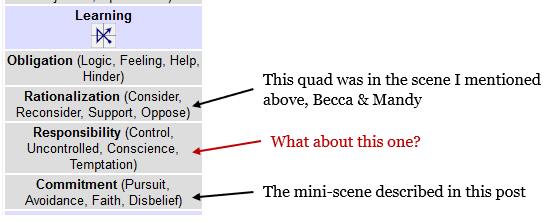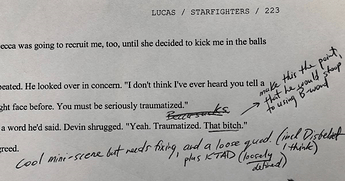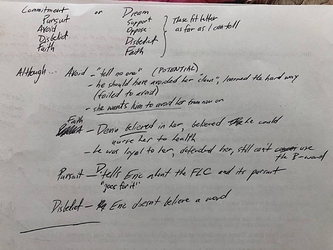Wow. Working on my revision the last couple weeks I have been utterly astounded with this PRCO stuff.
For example, the scene I did yesterday. It’s just this little 450 word scene. When I read over the first draft version I knew it needed some rejigging and wrote “cool but needs fixing, a PRCO quad, incl. Disbelief I think”.
Now, I knew that none of my PSR Variations at this point were from lower-left, so Disbelief couldn’t be one of their elements. But the Disbelief was so obvious that I decided it was ok, this scene was just a short bit highlighting the Skeptic character’s penchant for disbelief, which becomes really important later on. I figured it wasn’t part of the structure.
So I tried to figure out which quad, and picked the Dream one (Disbelief/Faith/Support/Oppose). But after going with that and starting to write I had second thoughts and realized the Commitment one (Disbelief/Faith/Pursuit/Avoid) fit way better. In fact, all those elements were already there in the first draft – but recognizing where they were made the rewriting much easier. (There were a couple wandering paragraphs where MC Devin struggles with his loyalty to Becca, and knowing that was Faith made it easier to tighten.)
I finished rewriting the scene, and was about to post about how it’s ok sometimes to just use a random quad that’s not part of the structure, for a short little scene highlighting character. I don’t disagree with that, but… Then I realized the Commitment quad was in the PSR at this exact point in the story! Once I again, I had missed it because it was part of the RS, and I wasn’t thinking of this as an RS scene, because the main RS characters weren’t both present.
In hindsight, that was kind of stupid – this scene is basically “the aftereffects of the huge salting-the-earth rejection that just happened in the relationship (previous scene)”. But I was so into the MC’s POV that I was thinking of it more as an MC scene. (Which may explain why I gravitated toward the Dream quad, actually, since Dream is the MC Counterpoint.)
Anyway, after all that I started wondering if the previous PSR item of Responsibility had shown up already. I had identified the Rationalization scene in the posts above (described in post #2, PSR-matched in #16). But for my recent scenes I hadn’t done any PRCO analysis, as they were really strong in first draft, and I didn’t need to change much.

So I started hunting. The obvious candidate was the big rejection scene I mentioned, which comes right before this one. Control and Uncontrolled were there for sure, but I had trouble seeing Conscience and Temptation at first, so I looked at some other scenes before coming back. Then I realized Conscience was HUGE in the subtext of this scene – it’s all about their guilty consciences over what happened between them, which ties into the Responsibility i.e. blaming.
And then, with that snapping into place feeling we’ve all come to associate with Dramatica, I realized what the Temptation (Outcome) was. Incredible, really – vastly different from anything I could have come up with consciously. It was basically just “being tempted to give up and just go home”. After all the pain they’re tempted to give up on the relationship, and they do (for now).
I just think it’s so cool how accurate the storyform can be, even down to the elements below the PSR – and all by following the main throughline story points, not even using the PSR in first draft.







